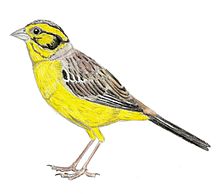Long-legged bunting
| Long-legged bunting Temporal range: Late Pleistocene-Holocene
| |
|---|---|

| |
| Hypothetical restoration based on known material and related species | |
| Scientific classification | |
| Domain: | Eukaryota |
| Kingdom: | Animalia |
| Phylum: | Chordata |
| Class: | Aves |
| Order: | Passeriformes |
| Family: | Emberizidae |
| Genus: | Emberiza |
| Species: | †E. alcoveri
|
| Binomial name | |
| †Emberiza alcoveri | |
The long-legged bunting (Emberiza alcoveri) is an extinct flightless species of bunting. It was distinguishable by its long legs and short wings, and it inhabited Tenerife, one of the Canary Islands. It is one of the few flightless passerines known to science, all of which are now extinct.
Taxonomy

This bunting belongs to the genus
Description
The
Distribution and habitat
The long-legged bunting was a native of the Canary Islands. Bones from this species have only been found in the volcanic cave Cueva del Viento, on the island of Tenerife. Other species that lived alongside this bunting include various birds, mammals, and lizards. This species likely lived in the laurel forest or the transition forest, as food would be plentiful and the herb layer would protect against aerial predators.[1]
Extinction
The long-legged bunting had lived in Tenerife during the
References
- ^ JSTOR 1370440. Retrieved 2008-08-01.
- ISBN 1-85391-186-0.
- ^ "Fossil records for the family Finches and Allies". KPN.com. Retrieved 2008-08-01.
